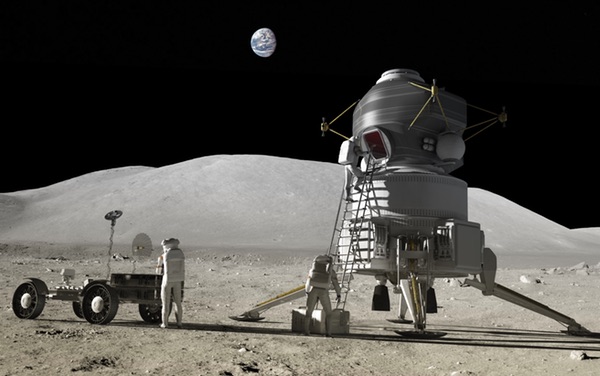Moon or Mars: Why not both?by Chris Carberry, Joe Cassady, and Rick Zucker
|
| We should not be asking ourselves, “Should we go to the Moon or to Mars?” Instead, we should be asking, “How can we achieve both goals?” |
As an example, earlier this year President Trump signed into law the NASA Transition Authorization Act of 2017, which contains the strongest language requiring human missions to Mars ever to be placed in a piece of legislation. This bipartisan bill was enacted after many years of growing momentum and consensus building.
Unfortunately, recently there has been a worrisome drumbeat emanating from some quarters that calls for the United States to return to the Moon at the expense of Mars. That is, some of these voices have advocated sidelining Mars indefinitely. To abandon Mars as the overarching goal of United States space policy, however, would be a huge mistake, and in the end it could very well undermine lunar aspirations as well.
We should not be asking ourselves, “Should we go to the Moon or to Mars?” Instead, we should be asking, “How can we achieve both goals?” Advocates for a return to the Moon and advocates for human missions to Mars are often portrayed as though they adhere to diametrically opposed ideologies, but this is not accurate. The divide between these groups is artificial, and results from limited budgets and inconsistent policy. In fact, the vast majority of people in the space industry, advocacy, and other relevant arenas share the same overarching goal, to have humanity move beyond low Earth orbit once again.
Commercial and international interest in lunar exploration and utilization has been steadily growing for years, and we welcome the participation of commercial lunar operators, who have argued that the Moon presents potential business opportunities. Assuming that a business case can be made for such activities, such proposals conform well to our longstanding view that NASA’s role should be to establish the outer boundaries and push the frontiers of human exploration, for which Mars is the acknowledged horizon goal.
While commercial interests can and should follow behind NASA, such enterprises, in order to be successful, must utilize space in a manner that produces sufficient profits that will justify the investment made in such pursuits. This includes paying the costs associated with developing the necessary landers, mining equipment, other infrastructure, and so on. That commercial interests have expressed a willingness to step up and spend their own funds to explore the potential of lunar resources bodes well for the further success of public-private partnerships in space. Mars exploration craft could provide commercial lunar interests with a ready market for their lunar-produced products, such as hydrogen and oxygen, if commercial lunar enterprises can show that they are able to produce and deliver such products at a reasonable price.
| The debate that has occurred between the two as to the “next destination” in space is the result of budgetary constraints and lack of political will, but in reality, the two are not mutually exclusive. |
However, these commercial activities must not become a barrier or prerequisite for going to Mars. NASA’s efforts to develop Mars capabilities in the lunar orbital environment can help facilitate these commercial partners’ goal of reaching the lunar surface. These are but two examples of how the commercial sector can participate and benefit from NASA’s planned Mars development, such as through a resource like the Deep Space Gateway.
This unified process would unite supporters and stakeholders of both Mars exploration and lunar surface activities. The debate that has occurred between the two as to the “next destination” in space is the result of budgetary constraints and lack of political will, but in reality, the two are not mutually exclusive. Given the choice, most people in the space exploration community would not reject an opportunity to achieve both goals (and more) as long as both can be accomplished in a timely and sustainable manner.
The United States is well-positioned to once again venture beyond the confines of Low Earth Orbit and continue where the Apollo program left off, but key decisions need to be made in the near term, consistent and adequate budgets need to be maintained, and space policy must remain focused and objective oriented. With a mandate from the Administration and Congress, NASA along with our nation’s commercial and international partners can lead us into a pivotal and epic new age in human history.
